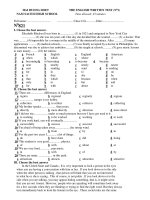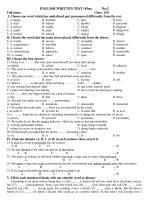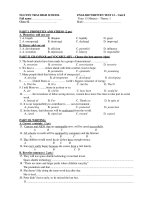English Written Test No3 doc
Bạn đang xem bản rút gọn của tài liệu. Xem và tải ngay bản đầy đủ của tài liệu tại đây (23.79 KB, 2 trang )
1
Le viet tao high school English written test – no_ 3
(Time allowed: 45 minutes)
Full name:…………………………………………………… Class 12………
Date of testing: ………/……… / 2010
I. Choose one word whose underlined part is pronounced differently by circling the corresponding letter A, B, C, or D.
1. A. compound B. route C. house D. south 1____
2. A. dune B. hummock C. shrub D. buffalo 2____
3. A. loose B. smooth C. food D. flood 3____
4. A. society B. geography C. dry D. sandy 4____
5. A. endangered B. destroyed C. damaged D. provided 5____
II. Choose the best answer by circling the corresponding letter A, B, C, or D.
6. I can’t find my book anywhere. I ……. have left it on the train. I am not sure.
A. must B. needn’t C. should D. might 6____
7. You ……….lunch. We have already eaten.
A. need prepare B. needn’t have prepared
C. should prepare D. should have prepared 7____
8. People have hunting animals ……. food and ivory.
A. on B. for C. in D. with 8____
9. Our environment is …………because of serious pollution and endangerment.
A. threat B. threatened C. threatening D. threaten 9____
10. He told me not to do it, ………, I did it.
A. Therefore B. so C. but D. However 10____
11. Although we are aware ………the importance of environment, we still overexploit it.
A. of B. on C. for D. from 11____
12. Many species have become extinct each year before biologists can identify them.
A. destroy B. drain C. endanger D. discover 12____
13. Keep quiet. You ………talk so loudly in here. Everybody is working.
A. may B. mustn’t C. must D. might 13____
14. The museum is opened to everybody. It …… between 9 a.m and 5 p.m .
A. visit B. visited C. can visit D. can be visited 14____
15. The Simpson Desert was named _______ Mr. Simpson, President of the South Australian Branch of the Royal
Geographical Society of Australia.
A. with B. at C. after D. for 15____
16. Mrs. Lindon has ________ that she is unable to get a job.
A. but not enough education B. such little education
C. however little education D. so little education 16____
17. It is reported that humans are the main reason for most species' declines and habitat _______ and degradation are the
leading threats.
A. destroy B. destructive C. destructor D. destruction 17____
18. _______ is the protection of environment and natural resources.
A. Survival B. Commerce C. Conservation D. Extinction 18____
19. _______ I be here by 6 o'clock? - No, you _______.
A. Shall/mightn't B. Must / needn't C. Will / mayn't D. Might / won't 19____
20. _______ is the existence of a wide variety of plant and animal species living in their natural environment.
A. Biodiversity B. Conservation C. Globe D. Individual 20____
III. There is one mistake in each of the following sentences. Identify by circling A,B, C or D:
21. Desert is a large area of land that has very little water however very few plants growing on it.
A B C D 21____
22. Rain falls occasionally in deserts so desert storms are often violent.
A B C D 22____
2
23. Species become extinct or endangerment for a number of reasons, but
A B
the primary cause is the destruction of habitat by human activities.
C D 23____
24. Although species evolve differently, most of them adapt to a specific
A B
habitat or environment that best meets their survive needs.
C D 24____
25. Such human activities as pollution, drainage of wetlands, cutting and clearing of forests, urbanization, and
A B C
road and dam construction has destroyed or :seriously damaged available habitats. 25____
D
IV. Fill in each numbered blank with one suitable word or phrase by circling the corresponding letter A, B, C, or D.
When the word "endangered" is mentioned, people usually think of particular species, like the panda or whooping
crane. However, we would like to encourage you to think about (26) ____ in a broader context. It is (27) ___, the physical
places where species live and interact with one another. Although the development of special breeding programs, also
known as captive conservation, may help some species in some cases, it is clearly not (28) ___ answer to the global
problem. Indeed, (29) __ we are able to protect natural areas where endangered species actually live, they have no future. .
Species become endangered for a wide (30) _____ of reasons. By analyzing and grouping many individual cases,
however, we find the same broad causes (31) _____ again and again. They are Habitat Destruction, Exotic Species, and
Overexploitation. Among other factors threatening particular species are limited: distribution, disease, and pollution.
Limited distributions are often a consequence of other threats: populations confined to one or a few small areas because of
habitat (32) _____, for example, may be disastrously affected by random factors. Diseases can have severe (33) _____ on
species lacking natural genetic protections against particular pathogens, like the rabies and canine distemper viruses that
are currently devastating carnivore populations in East Africa. Domestic animals are usually the reservoirs of these and
other diseases affecting wild (34) _____, showing once again that human activities lie at the root of most causes of
endangerment. Pollution has seriously done harm (35) _____ number of terrestrial species, although species living in
freshwater and marine ecosystems are also suffering.
26. A. development B. endangerment C. pollution D. contamination 26____
27. A. plants B. conservations C. habitats D. organizations 27____
28. A. a B. an C. the D. Ø 28____
29. A. so B. but C. if D. unless 29____
30. A. variety B. commerce C. extinction D. destruction 30____
31. A. expressing B. showing C. disappearing D. appearing 31____
32. A. benefit B. reserve C. loss D. gone 32____
33.A. impact B. interest C. infection D. absorption 33____
34. A. needs B. populations C. natures D. medicines 34____
35. A. to B. for C. with D. at 35____
V. Finish each of the following sentences in such a way that it means exactly the same as the sentences printed before it.
36. “What are you doing now?” The girl asked him.
A. The girl asked him what I was doing then. C. The girl asked him what he is doing then.
B. The girl asked him what he was doing then. D. The girl asked him what she was doing then. 36____
37. He no longer lived in the countryside.
A. No longer did he live in the countryside any more. C. No longer has he lived in the countryside.
B. No longer did he live in the countryside. D. No longer does he live in the countryside. 37____
38. He couldn’t buy this new car because he did not have enough money.
A. If he had enough money, he could buy this new car.
B. If he had had enough money, he could have bought this new car.
C. If he has had enough money, he could have bought this new car.
D. If he had enough money, he could buy this new car. 38____
39. They worked very hard in spite of their old age.
A. They worked very hard despite they were old. C. They worked very hard although they were old
B. They worked very hard despite they are old. D. A and C are correct 39____
40. John rarely goes to church on Sundays.
A. Rarely goes John to church on Sundays. C. Rarely does John go to church on Sundays.
B. Rarely John goes to church on Sundays. D. Rarely does John goes to church on Sundays. 40____









